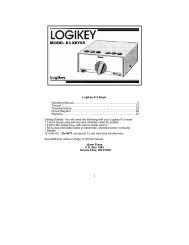4-BTV, 5-BTV, 6-BTV Multiband HF - K6RF Home of the Porta Base ...
4-BTV, 5-BTV, 6-BTV Multiband HF - K6RF Home of the Porta Base ...
4-BTV, 5-BTV, 6-BTV Multiband HF - K6RF Home of the Porta Base ...
You also want an ePaper? Increase the reach of your titles
YUMPU automatically turns print PDFs into web optimized ePapers that Google loves.
esistance and X=0 or ± j0 reactance are not realistic. The frequency where <strong>the</strong> lowest SWR occurs<br />
will likely result in analyzer readings that are not perfect.]<br />
If you only have an SWR or power meter use it at <strong>the</strong> antenna. Use your transceiver or analyzer<br />
and plot a chart <strong>of</strong> SWR measurements at several frequencies across <strong>the</strong> range below and above<br />
your target frequency, repeating after every antenna adjustment. Starting at a low frequency,<br />
record SWR measurements at regular increments higher in frequency to determine where <strong>the</strong><br />
lowest SWR occurs.<br />
When making antenna adjustments, DO NOT watch a certain frequency hoping for a minimum<br />
SWR to appear. Over-adjustment could cause you to miss <strong>the</strong> “dip” as it passes your target<br />
frequency. It is better practice to take enough readings in order to follow <strong>the</strong> minimum SWR point<br />
as you make adjustments so you can achieve low SWR at your target frequency. Make sure you<br />
adjust <strong>the</strong> antenna traps to<br />
frequencies that are going to<br />
be used, not simply in <strong>the</strong><br />
middle <strong>of</strong> <strong>the</strong> band.<br />
Hustler Traps<br />
The manufacturer sets <strong>the</strong><br />
traps to specific dimensions.<br />
Since you are optimizing <strong>the</strong><br />
antenna system using a good<br />
radial system, adjustments<br />
will have to be made. For<br />
reference, <strong>the</strong> photo below<br />
shows <strong>the</strong> traps as <strong>the</strong>y come<br />
from <strong>the</strong> manufacturer. You<br />
should mark spot where <strong>the</strong><br />
trap lower tube meets <strong>the</strong> trap<br />
sleeve with a felt tip marker.<br />
This will help in case you<br />
have to go back to <strong>the</strong> initial<br />
manufacturer's settings.<br />
[Note: The dimensions shown may vary due to manufacturing assembly tolerances.]<br />
In this tuning procedure we'll be talking about loosening <strong>the</strong> trap cover,<br />
loosening <strong>the</strong> band clamp and adjusting <strong>the</strong> trap sleeve. The picture to <strong>the</strong><br />
left shows <strong>the</strong>se parts.<br />
The manufacturer puts a silicone sealant inside <strong>the</strong> black plastic trap<br />
covers. Loosen <strong>the</strong> band clamp and twist <strong>the</strong> trap sleeve while holding <strong>the</strong><br />
black trap cover will loosen it. The silicone that was put in <strong>the</strong>re can be<br />
removed so <strong>the</strong> black trap cover and trap sleeve can be repositioned.<br />
Resealing <strong>the</strong> trap cover may not be necessary, as it grips <strong>the</strong> trap top tube<br />
tightly and <strong>the</strong> trap sleeve has slits at <strong>the</strong> bottom for moisture to escape. If<br />
you choose to use silicone sealer, be certain it is non-acetic (without a<br />
vinegar smell) and it does not contain metal (DXE-RTV598335).<br />
- 40 -



